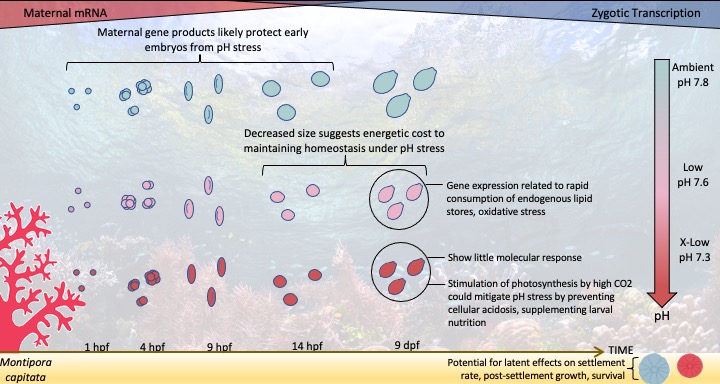Developmental timeseries of the reef-building coral Montipora capitata under predicted low and extreme low ocean acidification scenarios
Chille EE 1, Strand E 1, Scucchia F 2,3, Neder M 2,3, Schmidt V 4, Sherman MO 1, Mass T 2,5, Putnam HM 1
1 Department of Biology, University of Rhode Island, Rhode Island, USA
2 Department of Marine Biology, The Leon H. Charney School of Marine Sciences, University of Haifa, Haifa, Israel
3 The Interuniversity Institute of Marine Sciences, Eilat, Israel
4 Yale School of Medicine, Yale University, Connecticut, USA
5 Morris Kahn Marine Research Station, The Leon H. Charney School of Marine Sciences, University of Haifa, Sdot Yam, Israel
This repository provides data and scripts to analyze Monitpora capitata gene expression dynamics across five life stages from fertilization to 9-day planula under ambient (7.84 pH), low (7.64 pH), and extreme-low pH (7.34 pH) conditions. This analysis provides data characterizing the transcriptomic response of each developmental stage to ocean acidification during and after the Maternal-to-Zygotic transition (MZT).
In light of the chronic stress and mass mortality reef-building corals face under climate change, it is critical to understand the processes driving reef persistence and replenishment, including coral reproduction and development. Here, we quantified gene expression and sensitivity to ocean acidification across a set of developmental stages in the rice coral, Montipora capitata. Embryos and swimming larvae were exposed to pH treatments of 7.8 (ambient), 7.6 (low) and 7.3 (extreme low) from fertilization to 9 days post-fertilization. Embryo and larval volume, and stage-specific gene expression were compared between treatments to determine the effects of acidified seawater on early development. Although there was no measurable size differentiation between pH treatments at the fertilized egg and prawn chip (9 h post-fertilization) stages, early gastrulae and larvae raised in reduced pH treatments were significantly smaller than those raised in ambient seawater, suggesting an energetic cost to developing under low pH. However, no differentially expressed genes were found until the swimming larval stage. Notably, gene expression patterns of larvae developing at pH 7.8 and pH 7.3 were more similar than those of larvae developing at pH 7.6. Larvae from pH 7.6 showed upregulation of genes involved in cell division, regulation of transcription, lipid metabolism and response to oxidative stress in comparison to the other two treatments. Although low pH appears to increase energetic demands and trigger oxidative stress in larvae, the developmental process is robust to this at a molecular level, with the swimming larval stage reached in all pH treatments.
Execute all scripts in Rproj and knit to project
